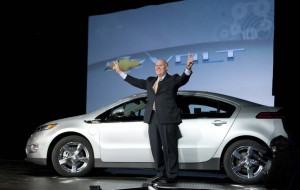General Motors will buy back a Chevrolet Volt from any owner worried about recent reports of fires following federal crash tests of the plug-in hybrid vehicle.
Nonetheless, demand for the Volt rose again during November, reaching 1,139 for the month and handily outselling its primary rival, the Nissan Leaf. But there appears to be no way that GM will be able to meet its original objective of selling 10,000 Volts this year.
GM will do whatever it takes to ensure the safety of the Chevy battery car, said CEO Dan Akerson during an interview published by the Associated Press, even if that means replacing the current lithium-ion battery pack. There have been three separate incidents involving the Volt batteries since one caught fire following a May crash test by the National Highway Traffic Safety Administration.
“If we find that us the solution, we will retrofit every one of them,” Akerson said in reference to the battery pack, which uses lithium-ion cells provided by South Korea’s LG Chem. “We’ll make it right.”
GM’s North American President Mark Reuss had previously announced the maker would offer loaner vehicles to Volt owners who didn’t want to drive the vehicle until the NHTSA investigation is completed.
All three incidents have occurred following NHTSA crash tests and GM has suggested the government agency may not have followed proper protocol by failing to discharge, or “de-energize” – the batteries after the tests. The regulatory agency announced late last month it was opening a preliminary investigation to see whether there is a safety issue, though so far there have been no reports of fires involving privately owned Chevrolet Volts.
Akerson said GM wants to address the problem “right now,” rather than waiting until there are far more of the plug-in hybrids on the road. The maker is all but certain to fall short of its 2011 sales goal as it has sold only 6,142 of the Chevy Volts for the first 11 months of the year.
But it has even more aggressive plans in place for 2012. Akerson wants to see 60,000 plug-ins roll out of the GM plant in Detroit – including a small number badged Opel Ampera for sale in Europe and China. Of those, 45,000 would be targeted at the United States.
Akerson told the AP it is possible a small number of potential customers might shy away from Volt after hearing the news reports – but he also stressed that the fires occurred only after the vehicle was put through an extreme accident and then stored for days, even weeks without any further steps being taken.
GM has tentatively linked the fires to the coolant fluid used in the battery pack. Normally inert, it may crystallize if exposed to the air after a crash penetrates the pack. Over time that could cause a short, the automaker told TheDetroitBureau.com last month.
Nissan CEO Carlos Ghosn, following an appearance at the Tokyo Motor Show this week, said he was not concerned about the results of the Volt crash test, “because it is a different battery.” There have been no reports of fires involving the Nissan Leaf – which uses an air-cooled, rather than liquid-cooled, lithium-ion pack.
But there are other reasons for concern at Nissan. During the first three quarters of 2011, Leaf sales were growing significantly faster than Volt’s. But that has reversed in recent months. After hitting 1.031 in September demand for the Japanese battery car slipped to 849 in October and just 623 last month.
For the year-to-date, Leaf sales are now at 8,720, putting it within reach of the 10,000 target Ghosn has set for the full year.

